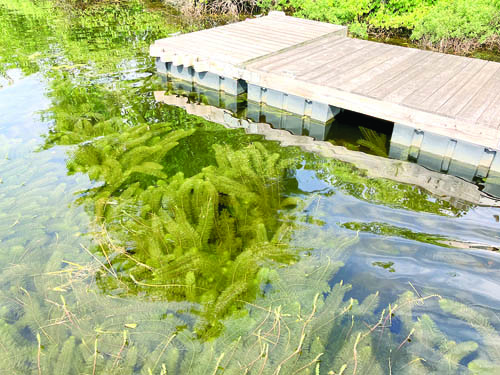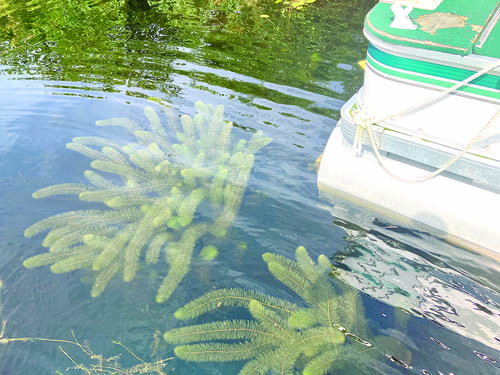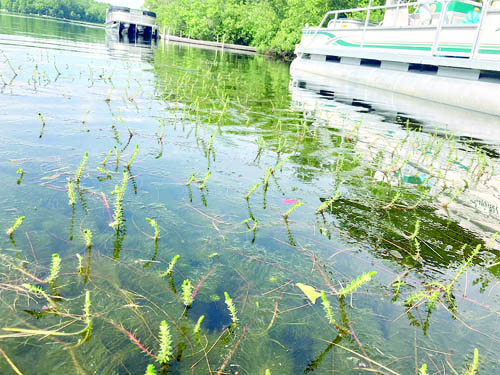Milfoil shows its ugly head at Cape Monday Cove

By Colin Holme
LEA Executive Director
HARRISON — Last Friday, I went out to see for myself the extent of the milfoil in Cape Monday Cove. The head of Lakes Environmental Association’s invasives control team, Michael Flannery, and our Long Lake divers had surveyed the area and the reports coming in were not good.
Back in 2020, we first found a patch of invasive variable leaf milfoil in the thin, shallow cove behind Zakelo Island that is west of Pine Point Road. We were able to smother that original patch with weighted tarps (benthic barriers) and suction harvest the remaining plants. In the subsequent years, we have routinely gone back to this cove to re-treat the same areas and manage any regrowth.
But this year, things sounded much worse. Our crew stated that plants were now dense in several parts this thin bay, flowering stalks were emerging from the water, and we had reports that it was growing in the larger part of Cape Monday Cove directly behind Zakelo Island. Our dive team was not able to find variable leaf milfoil growing in the larger part of the cove, but they had seen fragments in this area floating among native plants. This week, we are planning to start covering and removing the milfoil in this area so I wanted to see it first hand before any work started.
While I contemplated taking a power boat to save time, I wanted to get close without making things worse. So, after a plan to bring a canoe fell through, I took a paddleboard instead. I left from the end of Zakelo Road and paddled out in the shallows behind the island and around the rocks that stick up out of the water on the eastern side of the cove. Then, I zig-zagged various shallows in the larger open area. Not a thorough survey by any means, but I did go to the areas which were reported to have milfoil by a concerned landowner on the lake. What I saw was bladderwort, little floating heart, spatterdock, and eel grass, which are all natives, but no invasive milfoil. This was a relief. Unfortunately, this feeling did not last long.

I then paddled toward the narrow cove where we knew it was growing. Before I even got in the cove, I passed by a patch of little floating heart. Interspersed within the leaves of this native plant, was a long chunk of milfoil. The milfoil was not attached to the bottom. It was just a fragment floating. And this is what makes this plant so problematic. While many other plants need to first flower, then seed, then have the seed germinate, milfoil mainly reproduces through fragmentation. When it reaches the surface of the water, it begins growing laterally and it becomes very easy to chop up with a propeller. If it grows long enough, it will break off on its own to “auto-fragment,” which is a very effective reproduction technique.
As I continued to examine the small patch of floating heart, I found another fragment in it. I then paddled a little closer to the small cove and within another patch of native emergent plants were many pieces of milfoil detached and floating. I picked out all that I saw, then went to the next patch and did the same. As I continued paddling, I started seeing them just floating in the water on their own as I got a little deeper into the finger like cove.
Then, I saw the infestation. Thick patches of the plant growing behind and around a pontoon, right off a swim dock, and in deeper water. Looking around, I saw a pile of the plant drying on the dock.
The owners had obviously tried to remove it. I can’t blame them. They probably wanted a clear spot to jump in the water. I hope they were careful when they pulled it out because it spreads so easily. Our dive team always has someone surveying for and removing fragments when they are working. Even then, there is a concern that we can miss something.
This is not the only area in our region where milfoil has come back with vigor. I suspect that all the rain this year has brought in lots of nutrients, which the milfoil loves. Although we have had all this inclement weather, lake water temperature is still warm and milfoil grows fast in warm water.

Although I normally love a good paddle, this one left me feeling disheartened. It’s not that we don’t have the capability to deal with the milfoil in this cove. We have succeeded with more extensive infestations. But it is in a particularly vulnerable location. A large part of Cape Monday Cove is shallow and could easily be taken over by milfoil. In fact, on my way out, I continued to find more fragments floating in patches of native plants in the larger cove behind the Island. When I pulled my paddleboard out of the water, I saw a footlong fragment floating on the beach.
When it spreads into the main part of the cove, we could have a whole crew working in this cove all summer. But the reality is, our funding for milfoil control work is about to be halved. For the last four years, a private foundation has been covering the cost of about half of our milfoil control work. LEA spends a little over $200,000 a year paying for four dive teams that have cleaned out many areas that were inundated with this plant. The key to success with milfoil is getting it early and staying on top of it. The reason the private foundation funded our work for the last few years is because one of their board members saw how bad milfoil can get and convinced the foundation to invest where there is still a chance of keeping it at bay.
Last winter, LEA worked with local representative, Walter Riseman, to submit a bill to increase the lake and river protection sticker, which funds aquatic invasive control and prevention work throughout the state (and about a quarter of our control work program). While this bill did not pass, the Department of Inland Fisheries and Wildlife and the Department of Environmental Protection were directed to develop a comprehensive budget of what is needed to adequately fund this work. I look forward to seeing the results, but there is absolutely no doubt in my mind that we need to increase the cost of this sticker (which is currently $15 for in-state registered boats) and get lakefront landowners to chip in. Currently, only around 290 waterfront lot owners on Long Lake support our work. More than 800 do not. That might seem like a depressing statistic, but I think it shows how much more we could do if everyone saw the value in it.


